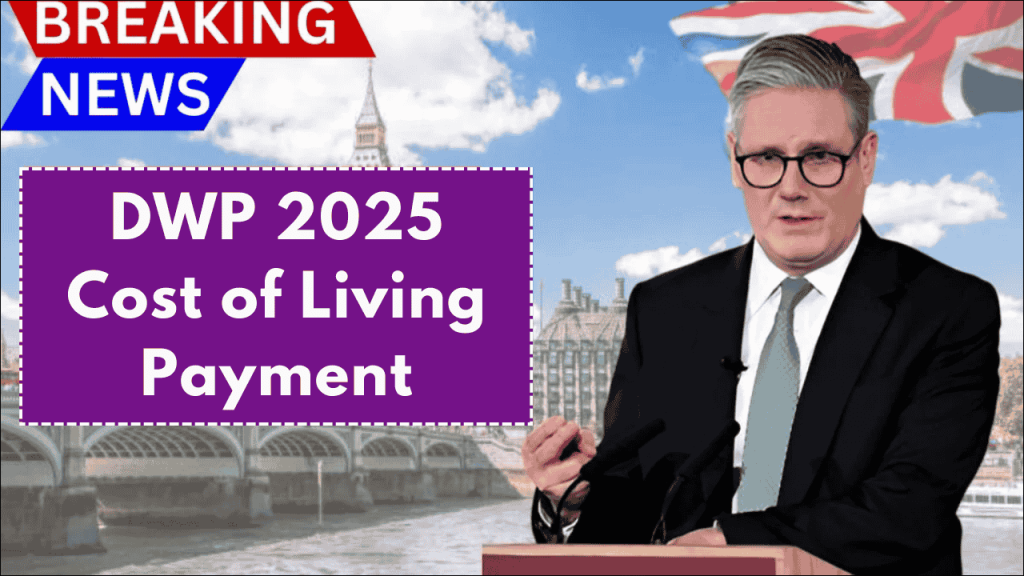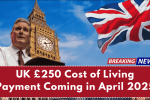
The persistent rise in inflation and soaring costs of daily essentials continue to place significant financial strain on millions of UK households. In response to these ongoing challenges, the Department for Work and Pensions (DWP) has announced a new round of Cost of Living Support payments for 2025. This comprehensive financial assistance package aims to provide crucial support to those receiving certain government benefits during these economically challenging times.
What Is the 2025 Cost of Living Payment Scheme?
Originally launched in 2022 during peak energy crisis and inflation, the Cost of Living Payment scheme has evolved into a more structured and systematic support program for 2025. The latest iteration will distribute financial aid ranging from £301 to £500 to eligible recipients across three strategic installments throughout the year.
A key advantage of this scheme is its automatic nature – eligible beneficiaries need not complete any application forms, as payments will be directly transferred to their bank accounts based on existing benefit records.
Payment Structure and Schedule for 2025
The government has thoughtfully divided the 2025 Cost of Living support into three seasonal payments to provide timely assistance when households might face increased financial pressure:
| Payment Phase | Timeline | Amount | Target Recipients |
|---|---|---|---|
| Spring Payment | March–May 2025 | £301 | All eligible benefit recipients |
| Summer Top-up | July–August 2025 | Up to £200 | Primarily disabled people and carers |
| Autumn Payment | October–December 2025 | Remaining balance (up to total of £500) | All eligible recipients |
This staggered approach ensures that support is distributed consistently throughout the year, helping recipients manage seasonal variations in expenses such as heating costs and school holidays.
Who Qualifies for the £301 Base Payment?
Eligibility for the base payment hinges on receiving at least one of the following means-tested benefits:
| Qualifying Benefits | Notes |
|---|---|
| Universal Credit | Must be in receipt during the qualifying period |
| Income-based Jobseeker’s Allowance (JSA) | Must be income-based, not contribution-based |
| Income-related Employment and Support Allowance (ESA) | Must be income-related, not contribution-based |
| Pension Credit | Any amount qualifies |
| Income Support | Any amount qualifies |
| Working Tax Credit | Administered by HMRC |
| Child Tax Credit | Administered by HMRC |
| Housing Benefit | Typically for pensioners |
For the most up-to-date information about eligibility criteria, visit the official DWP Cost of Living Payment page.
Additional Eligibility for Enhanced Support (Up to £500)
Certain individuals may qualify for additional top-up payments, bringing their total support to up to £500. These enhanced payments particularly target those with additional needs or higher living costs:
| Qualifying Circumstance | Additional Support Eligibility |
|---|---|
| Personal Independence Payment (PIP) | Summer top-up payment |
| Disability Living Allowance (DLA) | Summer top-up payment |
| Attendance Allowance | Summer top-up payment |
| Carer’s Allowance | Summer top-up payment |
| Health-related heating support | Additional autumn payment |
To check your potential eligibility for these disability benefits, you can use the Benefits Calculator on GOV.UK.
How Payments Will Be Made
The payment process has been designed to be as straightforward and hassle-free as possible:
- Automatic Processing: If you are eligible and receiving qualifying benefits, payments will be automatically deposited into the same account where you receive your regular benefits.
- Payment References: When checking your bank statement, look for these specific references:
- “DWP COL” for payments coming from the Department for Work and Pensions
- “HMRC COLP” for payments administered by HM Revenue and Customs
- Notification: While the DWP doesn’t typically send pre-payment notifications, you may receive a letter after the payment has been made.
Important Considerations to Ensure You Receive Your Payment
To ensure you don’t miss out on these vital payments, take note of these important considerations:
| Action Item | Why It’s Important |
|---|---|
| Keep bank details updated | Outdated details could delay or prevent payment |
| Ensure address information is current | Important communications may be sent by post |
| Regularly check benefit letters | May contain important information about eligibility periods |
| Monitor bank account during payment windows | To confirm receipt of payments |
You can update your personal details through your online Universal Credit account or by contacting the relevant benefit office directly.
The Significance of the 2025 Cost of Living Support
According to recent data from the Office for National Statistics (ONS), approximately one in four UK households continues to struggle with meeting essential expenses. The 2025 Cost of Living Payment scheme addresses these challenges in several crucial ways:
Economic Impact
The scheme provides targeted financial relief during specific periods when households might face increased costs:
- Spring payment: Helps with rising energy costs as winter ends
- Summer payment: Supports families during the school holiday period when childcare and food costs may increase
- Autumn payment: Assists with preparation for winter expenses
Social Protection
Beyond immediate financial relief, the support scheme serves wider social objectives:
- Preventing hardship: Reduces risk of food insecurity and utility disconnections
- Reducing indebtedness: Helps prevent households from accumulating debt to cover essentials
- Supporting vulnerable groups: Provides additional assistance to disabled people and carers
- Complementing other support: Works alongside existing mechanisms such as the Household Support Fund and energy bill support schemes
For comprehensive information about additional support available, visit the Help for Households government website.
Regional Distribution and Local Support
While the Cost of Living payments are administered nationally, additional support may be available at the local level:
| Region | Additional Support Options |
|---|---|
| England | Household Support Fund via local councils |
| Scotland | Scottish Welfare Fund and additional Child Payment |
| Wales | Discretionary Assistance Fund |
| Northern Ireland | Discretionary Support and additional schemes |
To discover what additional support might be available in your area, use the local council finder tool to locate your council’s website and explore their welfare support pages.
Protecting Yourself From Scams
Unfortunately, support schemes often attract fraudsters attempting to exploit vulnerable individuals. Be vigilant against:
- Phishing attempts: The DWP will never ask for your personal information via text or email
- Fake application processes: Remember, genuine Cost of Living Payments are automatic
- Charging for services: No legitimate organization will charge you to “facilitate” these payments
If you suspect you’ve encountered a scam related to Cost of Living payments, report it to Action Fraud or call 0300 123 2040.
What If You Don’t Receive Your Expected Payment?
If you believe you’re eligible but haven’t received your payment during the expected timeframe:
- Check your eligibility: Ensure you were receiving qualifying benefits during the relevant qualifying periods
- Verify your bank details: Confirm your payment information is up to date
- Contact the relevant department:
- For Universal Credit: Message via your online journal or call 0800 328 5644
- For Pension Credit: Call 0800 731 0469
- For other DWP benefits: Call 0800 169 0310
- For Tax Credits: Call HMRC on 0345 300 3900
For additional assistance with benefit-related queries, Citizens Advice offers free, confidential support.
Impact on Other Benefits and Tax Status
Many recipients have questions about how these payments might affect their wider financial situation:
- Tax status: Cost of Living Payments are non-taxable
- Benefit calculations: These payments do not count as income for benefit assessments
- Benefit cap: Payments are exempt from the benefit cap
- Savings limits: These payments do not count toward savings limits for means-tested benefits
Looking Beyond 2025
While the current scheme provides vital immediate support, longer-term strategies are being developed:
- Benefit uprating: Regular benefit increases to keep pace with inflation
- Energy efficiency programs: Reducing household energy costs through improved efficiency
- Skills and employment support: Enhancing earning potential through training and job support
To stay informed about future support schemes and updates to the current program, regularly check the GOV.UK Cost of Living support page.
Conclusion
The DWP 2025 Cost of Living Payment scheme represents a significant commitment to supporting vulnerable households during ongoing economic challenges. With payments ranging from £301 to £500 delivered across three strategic installments, this initiative provides crucial financial assistance to those receiving key benefits such as Universal Credit, Pension Credit, and disability benefits.
In times of persistent inflation and elevated costs for energy and essentials, this automatic support serves as a vital lifeline, promoting financial independence and security for millions of households. The scheme’s automatic nature eliminates bureaucratic barriers, ensuring that eligible recipients receive support without needing to navigate complex application processes.
The responsibility now falls to potential recipients to keep their details updated, confirm their eligibility, and remain vigilant against potential scams. By taking these simple precautions, individuals and families can ensure they receive this essential financial assistance during economically challenging times.
Frequently Asked Questions
How much can I expect to receive from the 2025 Cost of Living Payment scheme?
You could receive between £301 and £500 in total, depending on your specific benefits and circumstances. The amount is divided across three payments throughout the year.
Do I need to apply for the Cost of Living Payment?
No, there’s no application process. If you’re eligible, the payment will be automatically deposited into the same account where you receive your regular benefits.
When exactly will I receive each of the three payments?
Payments are scheduled in three phases: spring (March–May), summer (July–August), and autumn (October–December) 2025. Exact dates will be announced on the official DWP website.
Will receiving Cost of Living Payments affect my other benefits or tax situation?
No, these payments are non-taxable and won’t affect your eligibility for other benefits or be counted toward benefit caps or savings limits.
What should I do if I believe I’m eligible but haven’t received a payment?
Check your eligibility on the official GOV.UK website, ensure your bank and contact details are up to date, and if necessary, contact the relevant benefit office or helpline.
How can I protect myself from scams related to Cost of Living Payments?
Remember that genuine payments are automatic; the government will never contact you asking for personal or banking information to “process” your payment. Only trust information from official GOV.UK websites.

Isabell Johnson is a passionate writer known for captivating stories that blend imagination and reality. Inspired by travel, history, and everyday moments, She crafts narratives that resonate deeply with readers.

